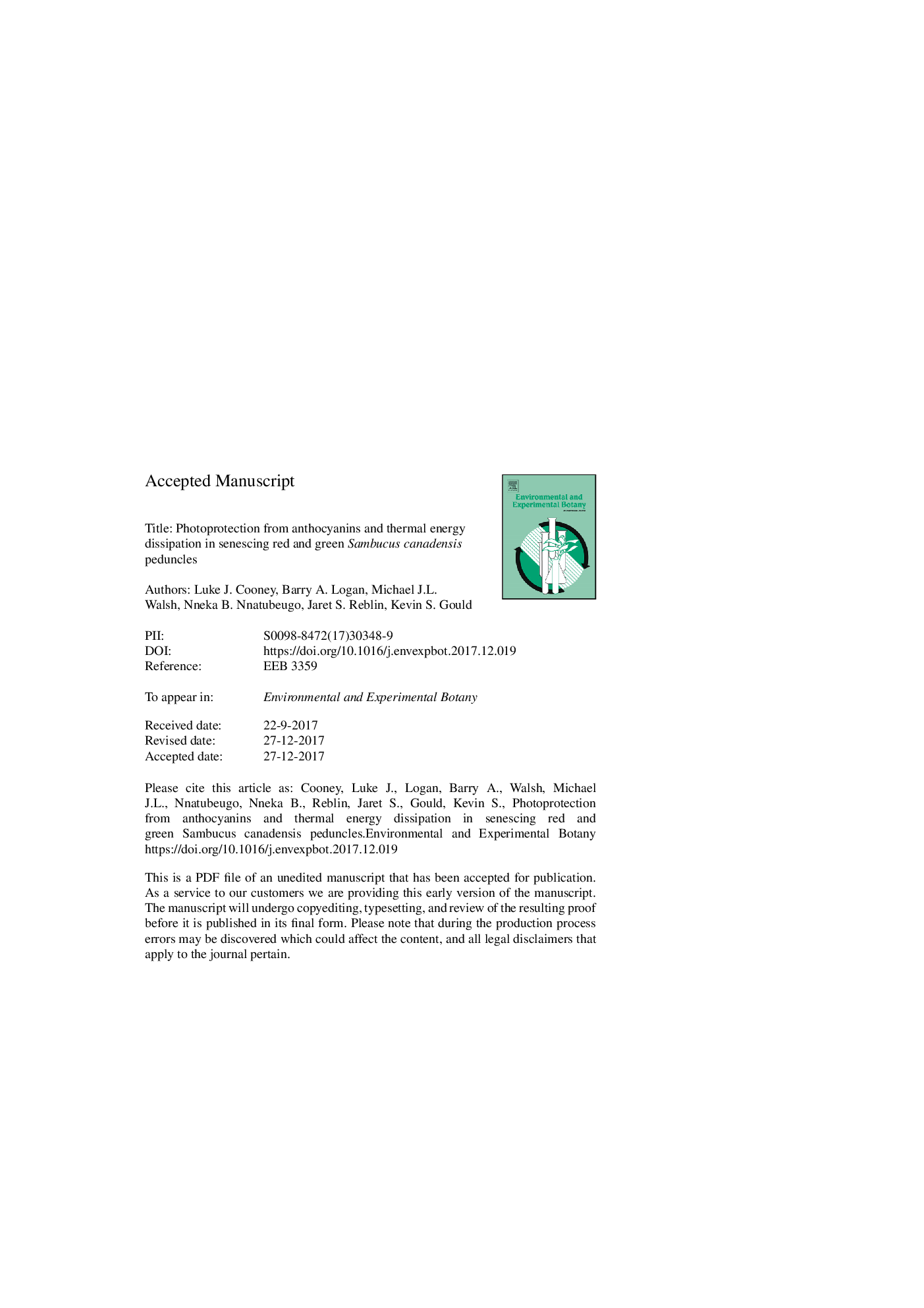| کد مقاله | کد نشریه | سال انتشار | مقاله انگلیسی | نسخه تمام متن |
|---|---|---|---|---|
| 8887038 | 1628029 | 2018 | 20 صفحه PDF | دانلود رایگان |
عنوان انگلیسی مقاله ISI
Photoprotection from anthocyanins and thermal energy dissipation in senescing red and green Sambucus canadensis peduncles
دانلود مقاله + سفارش ترجمه
دانلود مقاله ISI انگلیسی
رایگان برای ایرانیان
کلمات کلیدی
موضوعات مرتبط
علوم زیستی و بیوفناوری
علوم کشاورزی و بیولوژیک
بوم شناسی، تکامل، رفتار و سامانه شناسی
پیش نمایش صفحه اول مقاله

چکیده انگلیسی
Senescing photosynthetic tissues utilize a number of photoprotective mechanisms, including thermal energy dissipation involving the xanthophyll cycle, and often the screening of light energy by anthocyanins. The relative utilization of thermal energy dissipation when anthocyanins are present versus absent remains to be characterized. Using sun-acclimated Sambucus canadensis peduncles, which synthesize anthocyanins concomitant with fruit ripening, we compared pigment content (anthocyanins, carotenoids and chlorophylls) and chlorophyll fluorescence data (non-photochemical quenching [NPQ] and photochemical quantum yields of photosystem II, during and after prolonged light stress), before, during and after fruit ripening. Shade-acclimated peduncles, which remain green during senescence, were used for comparison. Additionally, we compared the xanthophyll cycle activity (i.e., constituents of the xanthophyll cycle) of sun- and shade-acclimated peduncles during fruit ripening. Before and during fruit ripening, when exposed to 1600â¯Î¼mol photons mâ2â¯sâ1 white light, shade-acclimated peduncles had higher NPQ values and, during fruit ripening, greater proportions of de-epoxidized xanthophyll cycle pigments than did the sun-acclimated peduncles, although both types incurred similar levels of photoinactivation (i.e., reduction in ΦPSII). After the fruit had ripened and peduncles were at the later stages of senescence, the green peduncles were photoinactivated significantly more than were the red ones, following light stress. Collectively, our data indicate that green peduncles, at the early stages of senescence, compensate for their absence of anthocyanins by invoking higher levels of energy dissipation. However, at the later stages of senescence, the level of compensatory thermal energy dissipation in green peduncles was insufficient, and was associated with greater levels of photoinactivation, compared to red peduncles. We conclude that photoprotection by anthocyanins augments the protective functions of xanthophyll cycle pigments in S. canadensis peduncles, and is especially important for mitigating effects of light stress towards the later stages of senescence in high light environments.
ناشر
Database: Elsevier - ScienceDirect (ساینس دایرکت)
Journal: Environmental and Experimental Botany - Volume 148, April 2018, Pages 27-34
Journal: Environmental and Experimental Botany - Volume 148, April 2018, Pages 27-34
نویسندگان
Luke J. Cooney, Barry A. Logan, Michael J.L. Walsh, Nneka B. Nnatubeugo, Jaret S. Reblin, Kevin S. Gould,